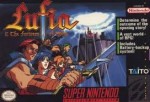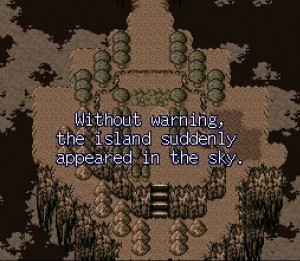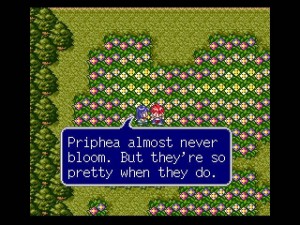Hello again, readers! It once again is time for Deimosion to review an old game that has long since become irrelevant to the current gaming culture! This week’s victim is Lufia and the Fortress of Doom for the Super Nintendo Entertainment System. Released in 1993, Lufia is a traditional JRPG in the vein of early Dragon Quest or Final Fantasy titles. Lufia and the Fortress of Doom, or Estopolis Denki as it was released in Japan, was developed by Neversoft and published by Taito. This often-overlooked cult classic is easily one of the most traditional JRPGs to appear on the SNES.
Lufia and the Fortress of Doom makes no attempts to innovate in its gameplay; it plays exactly like an older, turn-based Final Fantasy game. Turns are taken based on characters’ agility, with no real-time or active-time inputs necessary. Lufia uses a rigid class system of sorts, with no real party customization and an emphasis on combat and exploration. Very little can be said about the gameplay, honestly, as it is a highly traditional turn-based JRPG combat system that would not feel out of place on the NES rather than the SNES. There are a great many dungeons in Lufia, most of which are very short. Saving, like in most Dragon Quest titles, can unfortunately only be done in towns, within churches, though easy access to warping items and spells means the player is never far from a save point if necessary. Overall, the gameplay of Lufia and the Fortress of Doom is solid, but a bit unbalanced. The game starts off rather difficult and gets almost excessively easy later on, and the encounter rate ranges from slightly high to downright frustrating.
The story of Lufia is somewhat interesting: the game begins about a century before the main plot of the game as four heroes defeat a group named the Sinistrals (no, I am not making that up, their name really is that stupid) in an easy tutorial dungeon of sorts. The storyline then flashes forward one hundred years to the main character, an unnamed descendent of the leader of the original four. The hero and his love interest, the titular Lufia, soon learn that the Sinistrals are no longer dead and have returned to life to cause some sort of vague evil plan to come into fruition. Joining the hero and Lufia are Aguro, an army general, and Jerin, a half-elf mage. The party of four, nearly identical in makeup to the party used in the tutorial, sets off on its quest to stop the Sinistrals and once again bring peace to the world. The plot of Lufia is highly clichéd to be sure, but is most certainly not without interesting twists and turns. The character cast is boring and generic, however, and the setting is not particularly memorable.
Musically speaking, Lufia is, well, not particularly noteworthy one way or the other. While the battle music and the boss music are decent, the music is not so much bad as it is completely forgettable. The music of Lufia is decent, but the incessant reusing of dungeon themes does get rather annoying. Since the areas in Lufia are typically very short, with dungeons usually taking no longer than twenty minutes, the player is rarely in one place long enough for the music to get terribly obnoxious or grating. The graphics of Lufia and the Fortress of Doom are actually quite good, and fit the mood of the game extremely well. The sprite-driven graphics create the atmosphere one would expect of a traditional JRPG, and for a game released in 1993, Lufia looks significantly better than many of its contemporaries. The character sprites are colorful, and the feel of the graphics in general is that of a bright, vibrant world.
Overall, Lufia and the Fortress of Doom is a game that is good but not great. One looking for a traditional RPG on the SNES need look no further than this little-known cult classic of a game. While certainly no Chrono Trigger or Final Fantasy VI, for a classic RPG on the SNES, Lufia and the Fortress of Doom is still a game worth checking out.


